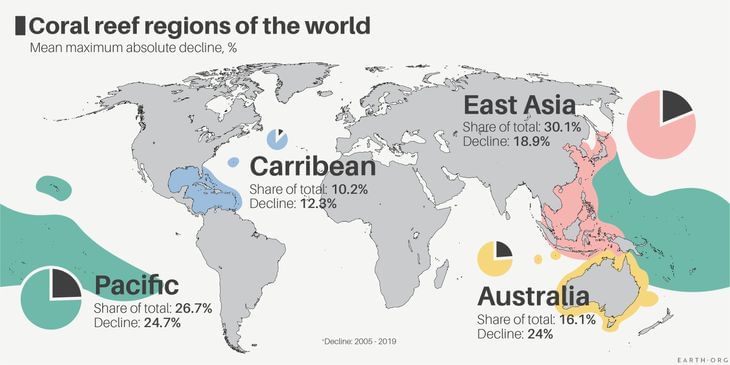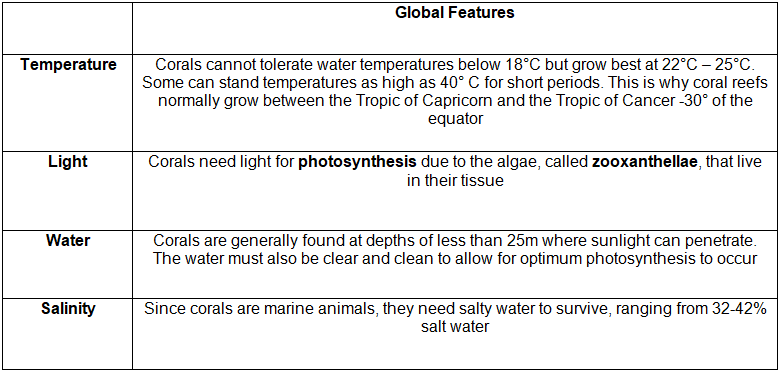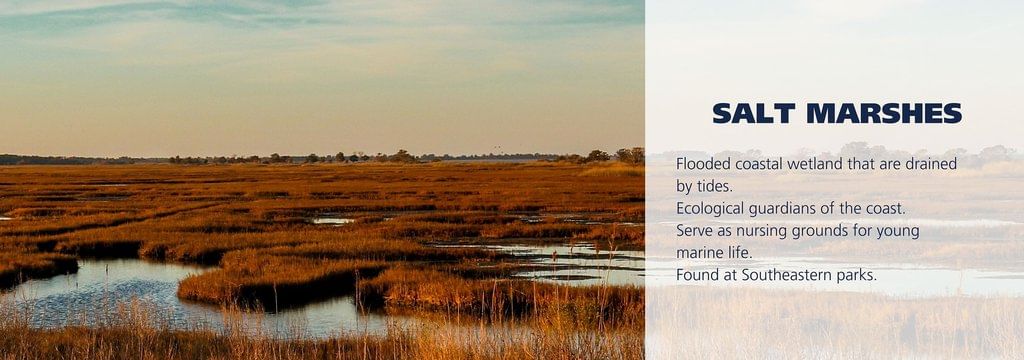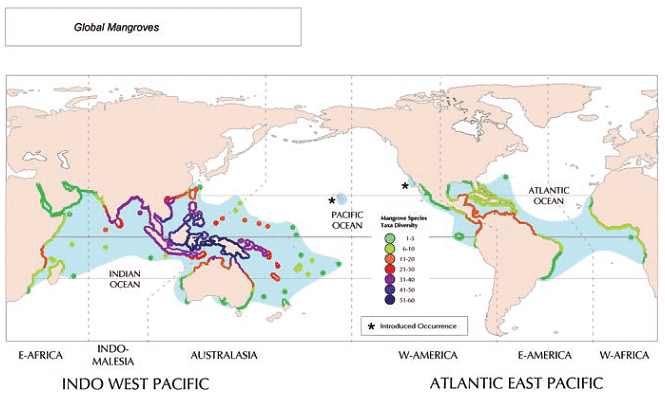Class 10 Exam > Class 10 Notes > Geography for GCSE/IGCSE > Coastal Ecosystems
Coastal Ecosystems | Geography for GCSE/IGCSE - Class 10 PDF Download
Coral Reefs
- Coral reefs and atolls form through the accumulation and compression of lime-secreting marine animal skeletons known as polyps.
- Living coral polyps inhabit only the upper and outer regions of the coral reef.
- The hard, calcareous skeletons of coral polyps develop through successive generations, building an upward and outward reef structure.
- Corals require a solid surface for growth initiation, which could be provided by a shipwreck or external debris.
- Coral reefs align parallel to the coast, featuring breaks at river mouths.
- Due to their high sensitivity, coral reefs have specific environmental requirements for growth.

- Corals are found in tropical and subtropical regions of the Western Atlantic and Indo-Pacific oceans, typically between 30°N and 30°S latitudes.
- Western Atlantic reefs are located in various areas including Bermuda, the Bahamas, the Caribbean Islands, Belize, Florida, and the Gulf of Mexico.
- The Indo-Pacific Ocean region stretches from the Red Sea, the Persian Gulf, across the Indian and Pacific oceans, to the western coast of Panama.
- Corals thrive on rocky outcrops in certain parts of the Gulf of California.
- The Great Barrier Reef in northern Australia is famous for its vast biodiversity and enormity; it's even visible from space.
- The distribution of corals is influenced by four key factors: temperature, light, water depth, and salinity.
Features of coral reefs

At a local level, other factors will affect development:
- Wave Action: Wave action is crucial for corals as it ensures well-oxygenated and clean water, vital for their survival. The movement of waves helps in providing the necessary oxygen and nutrients to the coral reefs.
- Exposure to Air: While corals need oxygenated water, prolonged exposure to air can be harmful as it may lead to their death. Corals must stay submerged to thrive and cannot withstand extended periods out of water.
- Sediment Impact: Clear and clean water is essential for corals. Sediment in the water obstructs their feeding patterns by reducing light availability, which is crucial for the photosynthesis process of the algae living within the coral polyps.
Types of coral reefs

Salt Marshes
Distribution of salt marshes
- Salt marshes are globally distributed and not limited by temperature variations.
- Similar to mangroves, they thrive within the intertidal zone's ecosystem.
- Typically, salt marshes are quite level and contain numerous channels.
- They develop in:
a. Coastal regions that offer adequate protection, like inlets and estuaries, facilitating the deposition of fine sediments.
b. Areas located behind spits and man-made sea barriers, where tidal waters flow gently, enabling the deposition of fine sediments. - Salt marshes form in brackish water.

Features of Salt Marshes
- Salt marshes are habitats dominated by non-woody, salt-tolerant plants.
- They originate as tidal mud flats, gradually elevating as sediment accumulates.
- This elevation ensures that the soil remains waterlogged, preventing it from drying out.
- Pioneer halophyte plants are the first to inhabit these marshes.
- As these plants decay, enriching the soil, sediment accumulates, fostering the growth of diverse species.
- Vegetation development over time, termed succession, specifically in salt marshes, is known as halophyte succession.
- Lower marshes are submerged daily by the high tide, serving as natural defenses against coastal erosion.
- While they act as coastal buffers in some regions, human activities like agriculture and development threaten their existence in many areas.
Mangrove Swamps
Distribution of mangroves
- Mangroves and coral reefs thrive in warm tropical waters. However, mangroves, unlike coral reefs, exhibit a remarkable ability to adapt to changing environmental conditions, making them one of the most resilient ecosystems on the planet.
- The adaptability of mangroves has contributed to their widespread success, allowing them to flourish in various habitats.

- Mangroves originated in south-east Asia and have since spread across the globe, primarily inhabiting warm tropical waters and coastal swamps within 30 degrees north and south of the equator.
- Some mangrove species have successfully adapted to more temperate climates, extending their range to regions as distant as New Zealand's North Island.
- These unique ecosystems thrive in the intertidal zone of coastlines, demonstrating their ability to withstand fluctuating water levels.
- South-East Asia boasts the highest biodiversity of mangroves globally, showcasing the variety of species that inhabit these regions.
Key Features of Mangroves
- Mangroves are a type of trees that thrive along coastlines, inhabiting areas with water levels ranging from 0.5 to 2.5 meters.
- They vary in size, ranging from small shrubs to towering trees exceeding 60 meters in height.
- Mangroves possess a dense network of tangled roots that grow above ground, forming thickets that provide crucial support.
- These trees require high levels of humidity (75 - 80%) and an annual rainfall between 1500 to 3000 mm.
- While they typically prefer an ideal temperature of around 27°C, mangroves are starting to adapt to more moderate climates.
- The root system of mangroves is intricate, featuring a filtration mechanism that aids in excluding salt.
- Some mangrove species have specialized roots resembling snorkels, protruding from the mud to facilitate air intake.
- Other varieties utilize 'prop' roots or 'buttresses' to maintain the vertical stability of their trunks in the soft sediment found at the tidal boundaries.

- Roots play a crucial role in trapping mud, sand, and silt, gradually forming new land in the intertidal zone.
- Mangroves simultaneously expand into new intertidal areas.
- The fruits and seedlings of mangroves possess the ability to float, traveling long distances via ocean currents.
- When carried by the tide, they settle in the mud, initiating growth and colonizing fresh territories.
Question for Coastal EcosystemsTry yourself: What is the main reason for the widespread success of mangroves?View Solution
The document Coastal Ecosystems | Geography for GCSE/IGCSE - Class 10 is a part of the Class 10 Course Geography for GCSE/IGCSE.
All you need of Class 10 at this link: Class 10
|
55 videos|68 docs|78 tests
|
FAQs on Coastal Ecosystems - Geography for GCSE/IGCSE - Class 10
| 1. What are the main threats to coral reefs? |  |
Ans. The main threats to coral reefs include climate change, ocean acidification, overfishing, pollution, and physical damage from activities like anchoring and diving.
| 2. How do salt marshes protect coastlines from erosion? |  |
Ans. Salt marshes protect coastlines from erosion by trapping sediments and reducing wave energy. The plants in the marshes also help stabilize the soil with their roots.
| 3. Why are mangrove swamps important for coastal ecosystems? |  |
Ans. Mangrove swamps are important for coastal ecosystems because they provide habitat for a variety of marine species, protect coastlines from storms and erosion, and help filter pollutants from the water.
| 4. How do coral reefs support biodiversity in marine ecosystems? |  |
Ans. Coral reefs support biodiversity in marine ecosystems by providing habitat for a wide range of marine species, including fish, crustaceans, and other organisms. The complex structure of coral reefs also offers shelter and protection for many species.
| 5. What are some ways to protect and conserve coastal ecosystems? |  |
Ans. Some ways to protect and conserve coastal ecosystems include reducing carbon emissions to combat climate change, implementing sustainable fishing practices, reducing pollution from runoff and waste, and establishing marine protected areas to preserve critical habitats.
Related Searches















